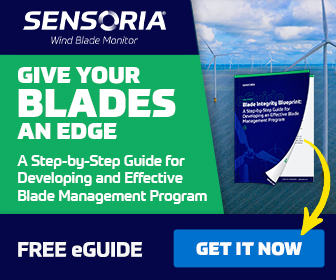Milling About: Achieving better blade-to-generator connections with orbital milling machines
 Recent breakthroughs are finally allowing major commercial offshore wind farms to be built in the United States. In May, the federal government approved areas off the coast of California and Massachusetts to be developed for wind turbines, and many more projects are up for review. The wind industry is not just growing in terms of the number of towers being built, the turbines themselves are becoming larger in size. Safely constructing wind towers would not be possible without a key step in the turbine blade manufacturing process - orbital milling.
Recent breakthroughs are finally allowing major commercial offshore wind farms to be built in the United States. In May, the federal government approved areas off the coast of California and Massachusetts to be developed for wind turbines, and many more projects are up for review. The wind industry is not just growing in terms of the number of towers being built, the turbines themselves are becoming larger in size. Safely constructing wind towers would not be possible without a key step in the turbine blade manufacturing process - orbital milling.
When wind turbine rotor blades are manufactured, the mold can create small, half joint steps on the surface where the blade connects to the generator. When bolting the two together during tower construction, joint integrity is dependent upon achieving a flatness tolerance to make a secure connection. Otherwise, the rotor blade could vibrate and affect performance - in a worst-case scenario, the blade's constructed integrity could be impaired.
Often, the engineering team behind the rotor blade will set the flatness tolerance in conjunction with the generator manufacturer. The team will then work with vendors who can help them achieve the accuracy needed, which is measured during the testing and inspection phase. Commonly accepted tolerances in the industry are a global flatness of 0.3mm around the diameter, and a local flatness of 0.05mm along a 300mm radial path or across 3off steel inserts within the route diameter.
Many wind turbine manufacturers have found these tolerances difficult to achieve with a traditional grinding machine. Thanks to new technology available in orbital milling machines, the job can now be completed quickly, safely, and accurately. Orbital milling machines can also tackle the larger rotor blades that are becoming increasingly common in the industry.
Orbital milling machines are designed to deliver fast material removal while achieving high accuracy across large flange diameters. The machines use a rotating table, are affixed to the end of the rotor blade, and hooked up to a hydraulic power pack with hoses. The combined orbital milling machine and hydraulic base are set within the commissioning period to achieve the specified machining tolerances. The combined assembly will repeat and achieve the required tolerances blade after blade; the process for an average size rotor blade takes just 30 minutes.

In addition to speed, orbital milling machines also improve worker health and safety because the debris produced can be better controlled. Compared to a grinding head that generates a lot of dust and other hot material moving at a fast velocity, a milling machine creates metal chips that can be contained with an optional vacuum system. Additionally, the rigid, independent bases on orbital milling machines provide ultimate worker safety, ensuring maximum performance each time they are used.
 Another benefit of orbital milling machines is maneuverability. The large size of turbine blades makes them hard to move around a factory. Rather than depending on the facility crane to bring the rotor blades to a machine to be worked on one by one, an orbital milling machine can be moved around the factory to each rotor blade. Some units come equipped with an installation trolley that holds the machine along with the hydraulic power pack and optional vacuum; this gives workers greater flexibility to move from blade to blade throughout the manufacturing plant.
Another benefit of orbital milling machines is maneuverability. The large size of turbine blades makes them hard to move around a factory. Rather than depending on the facility crane to bring the rotor blades to a machine to be worked on one by one, an orbital milling machine can be moved around the factory to each rotor blade. Some units come equipped with an installation trolley that holds the machine along with the hydraulic power pack and optional vacuum; this gives workers greater flexibility to move from blade to blade throughout the manufacturing plant.
To accommodate the growth in the size of turbine rotor blades (from small 18-meter models, to the newer 107-meter models), there are a range of machines available to service each size. Models are based upon the inside diameter, or ID, of the face to the machine.
Today's orbital milling machines are both simple and easy to use. Traditionally, an operator would rely in large part on their instinct - listening and feeling for vibration to gauge progress. Even though the machine itself is quite large, it's simple to operate. It uses standard tooling available worldwide, and can be operated completely manually, though customers are beginning to ask about PC-controlled milling machines to be used as an aid. Such information-based machines can provide early warnings such as notifying the operator when the cutters wear, or alerting them if there is any movement that is unacceptable.
As the wind industry continues to progress toward even larger wind turbines, customers are already beginning to inquire about orbital milling machines capable of handling a potential 120-meter rotor blade. Whether the future is larger turbines or lighter materials, orbital milling machine providers are busy creating a family of products for wherever the wind blows next.
Mick Handsley is a technical support manager for Mirage machines at Enerpac, a global provider of high-pressure hydraulic tools, controlled force products, portable machining, on-site services and solutions for precise positioning of heavy loads. He can be reached at [email protected]
Enerpac | www.enerpac.com
Author: Mick Handsley
Volume: 2021 July/August












.jpg?r=5139)